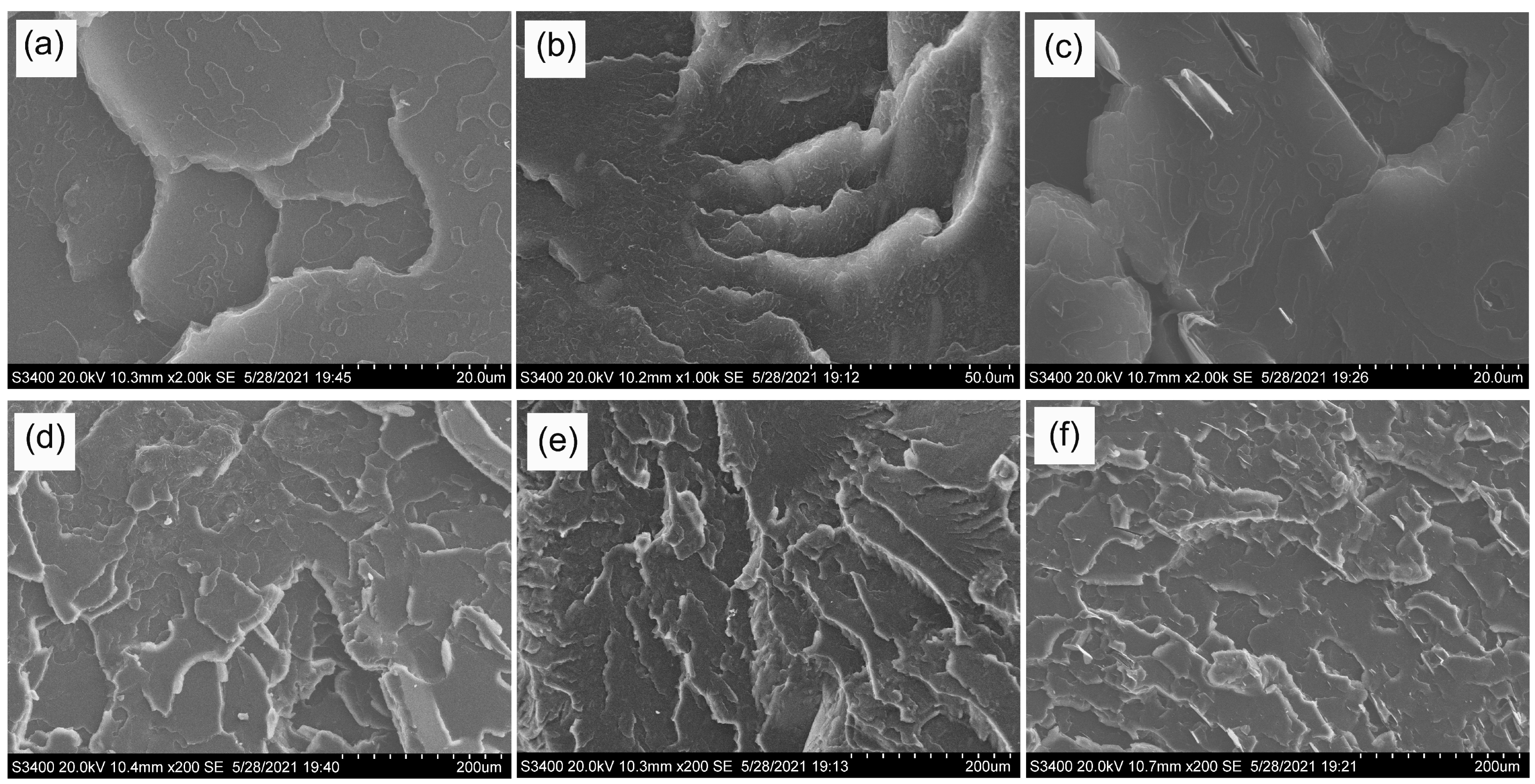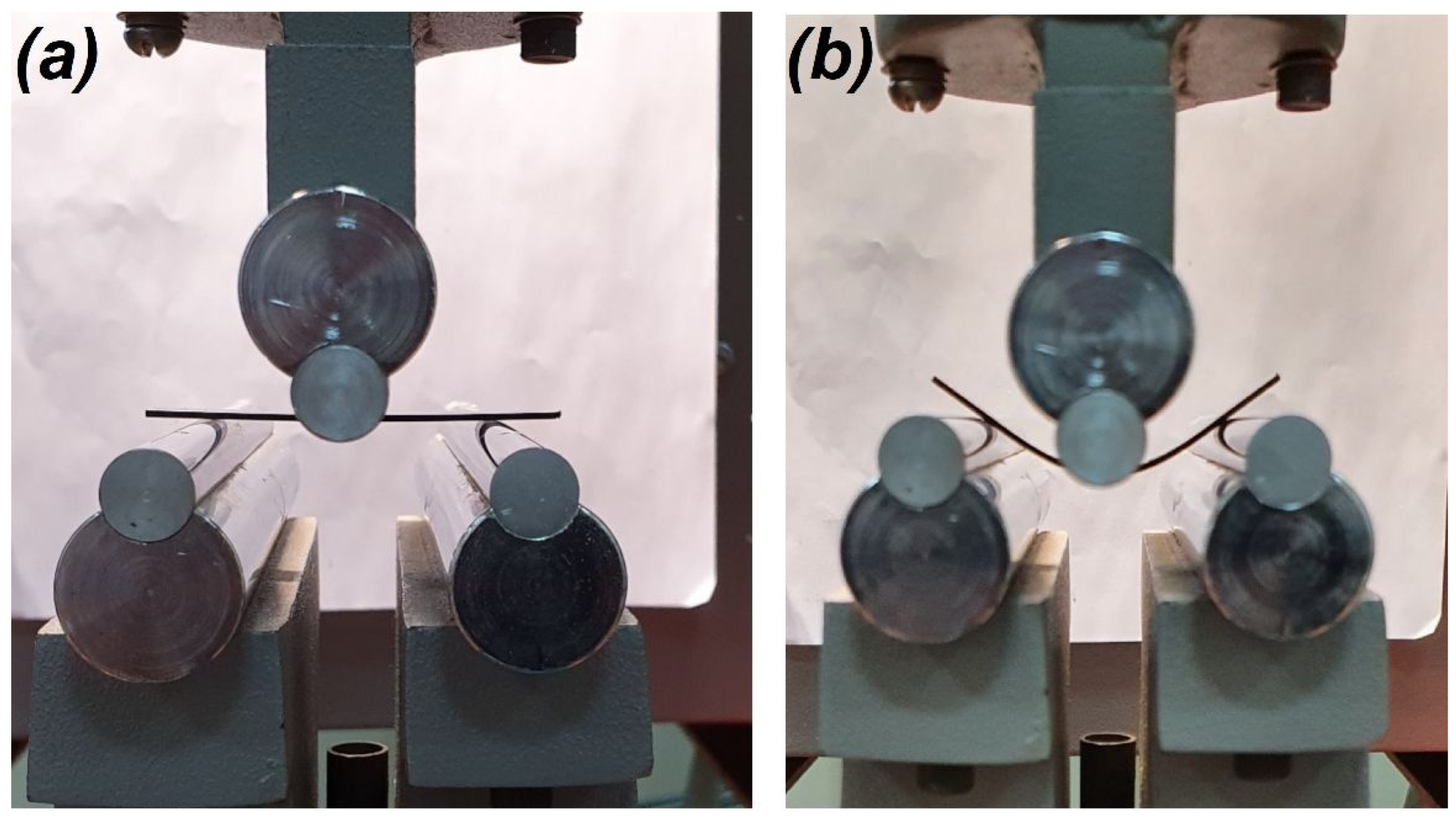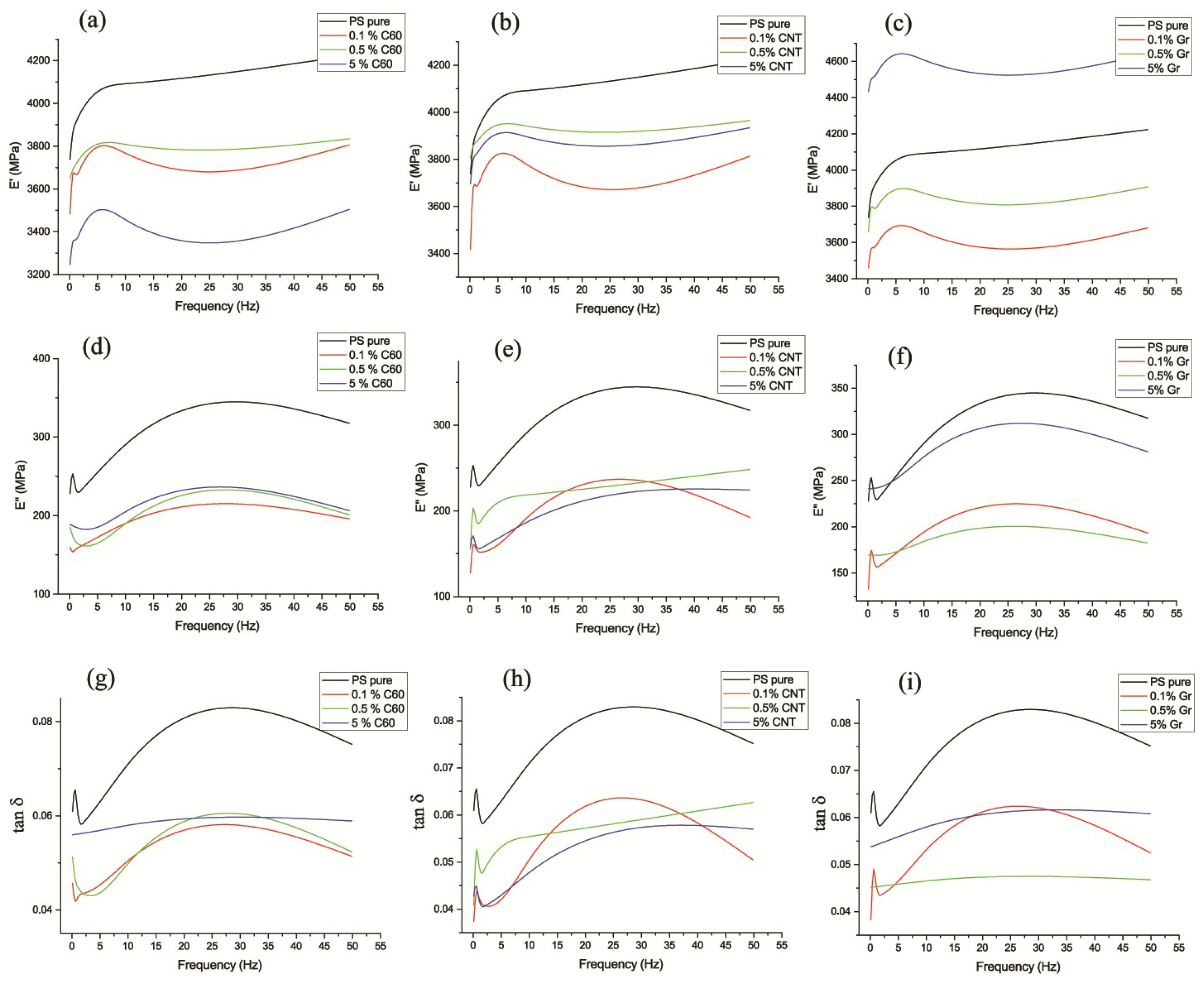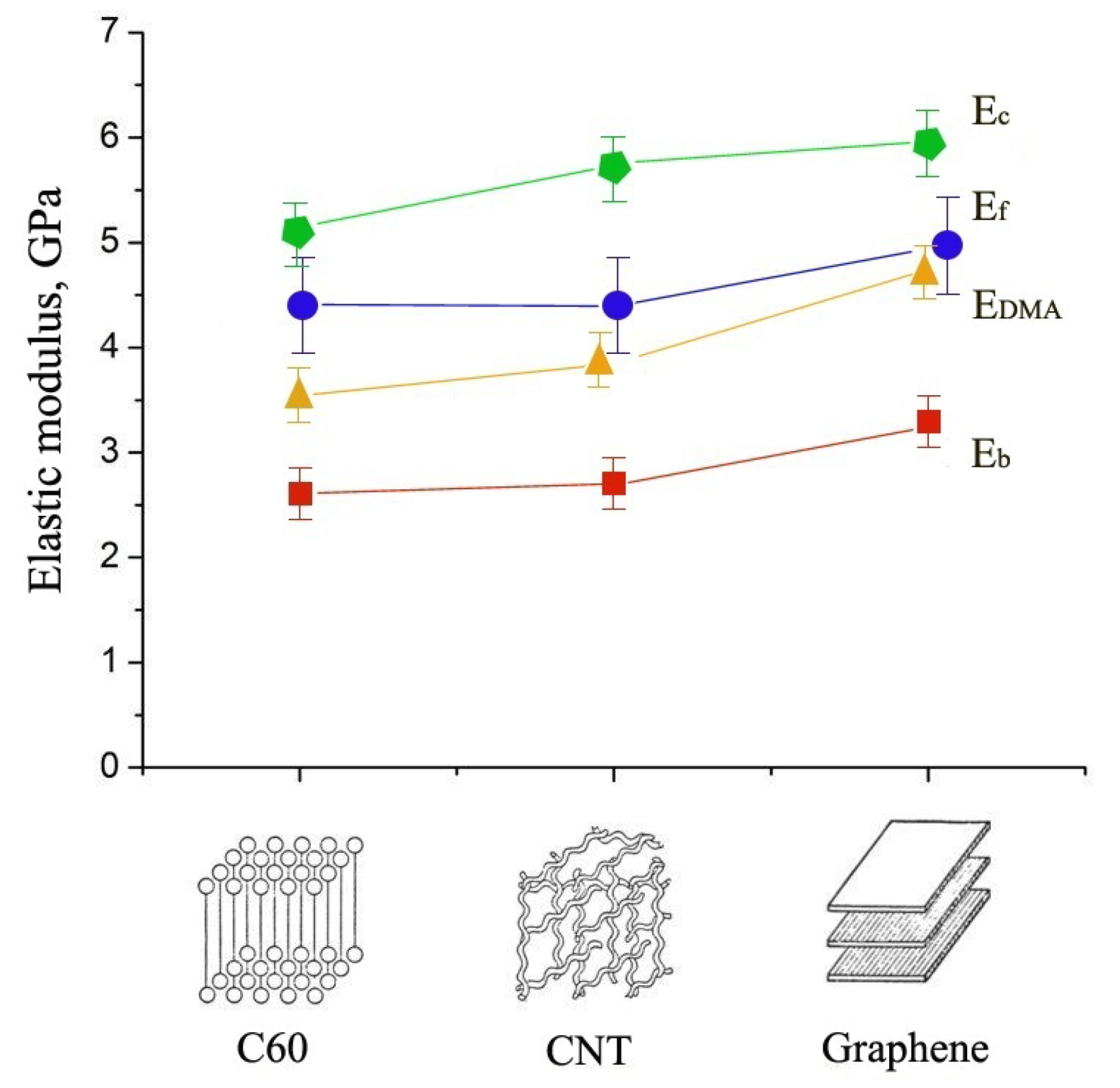Mechanical Performance of Polystyrene-Based Nanocomposites Filled with Carbon Allotropes
Abstract
:1. Introduction
2. Materials and Methods
2.1. Materials
2.2. Fabrication of Composite Samples
2.3. Measurement Methodology
3. Results and Discussion
3.1. Tensile Tests
3.2. Three-Point Bending Tests
3.3. Dynamic Mechanical Analysis
3.4. Elastic Moduli Obtained from Ultrasonic Measurements
3.5. Discussion
4. Conclusions
Author Contributions
Funding
Institutional Review Board Statement
Informed Consent Statement
Data Availability Statement
Acknowledgments
Conflicts of Interest
References
- Jeon, I.Y.; Baek, J.B. Nanocomposites Derived from Polymers and Inorganic Nanoparticles. Materials 2010, 3, 3654–3674. [Google Scholar] [CrossRef] [Green Version]
- Nalwa, H.S. Encyclopedia of Nanoscience and Nanotechnology; American Scientific Publishers: Valencia, CA, USA, 2004. [Google Scholar]
- Sachdev, V.K.; Bhattacharya, S.; Patel, K.; Sharma, S.K.; Mehra, N.C.; Tandon, R.P. Electrical and EMI shielding characterization of multiwalled carbon nanotube/polystyrene composites. J. Appl. Polym. Sci. 2014, 131, 40201. [Google Scholar] [CrossRef]
- Hanemann, T.; Szabó, D.V. Polymer-Nanoparticle Composites: From Synthesis to Modern Applications. Materials 2010, 3, 3468–3517. [Google Scholar] [CrossRef]
- Friedrich, K.; Fakirov, S.; Zhang, Z. (Eds.) Polymer Composites—From Nano- to Macroscale; Springer: Berlin/Heidelberg, Germany, 2005. [Google Scholar]
- Calleja, J.F.B.; Michler, G. (Eds.) Mechanical Properties of Polymers Based on Nanostructure and Morphology; CRC Press: Boca Raton, FL, USA, 2005. [Google Scholar]
- Liu, H.; Wen, S.; Wang, J.; Zhu, Y. Preparation and characterization of carbon black-polystyrene composite particles by high-speed homogenization assisted suspension polymerization. J. Appl. Polym. Sci. 2012, 123, 3255–3260. [Google Scholar] [CrossRef]
- Zhou, S.; Hrymak, A.N.; Kamal, M.R. Effect of Hybrid Carbon Fillers on the Electrical and Morphological Properties of Polystyrene Nanocomposites in Microinjection Molding. Nanomaterials 2018, 8, 779. [Google Scholar] [CrossRef] [Green Version]
- Yeh, S.K.; Su, C.C.; Huang, J.M.; Ke, M.Q.; Bogale, D.; Anbarasan, R.; Tung, K.L.; Wang, S.F. Fabrication of polystyrene/carbon nanocomposites with superior mechanical properties. Polym. Eng. Sci. 2020, 60, 2046–2056. [Google Scholar] [CrossRef]
- Ayewah, D.O.O.; Davis, D.C.; Krishnamoorti, R.; Lagoudas, D.C.; Suec, H.J.; Willson, M. A surfactant dispersed SWCNT-polystyrene composite characterized for electrical and mechanical properties. Compos. Part A Appl. Sci. Manuf. 2010, 41, 842–849. [Google Scholar] [CrossRef]
- Ginzburg, B.M.; Shibaev, L.A.; Kireenko, O.F.; Shepelvskii, A.A.; Melenevskaya, E.Y.; Ugolkov, V.L. Thermal degradation of fullerene-containing polymer systems and formation of tribopolymer films. Polym. Sci. Ser. A 2005, 47, 160–174. [Google Scholar]
- Bhattacharya, M. Polymer Nanocomposites—A Comparison between Carbon Nanotubes, Graphene, and Clay as Nanofillers. Materials 2016, 9, 262. [Google Scholar] [CrossRef] [Green Version]
- Mohammed, A.; Rao, D.N. Investigation on mechanical properties of flax fiber/expanded polystyrene waste composites. Heliyon 2023, 9, e13310. [Google Scholar] [CrossRef]
- Ahmad, M.N.; Ishak, M.R.; Taha, M.M.; Mustapha, F.; Leman, Z. Mechanical, thermal and physical characteristics of oil palm (Elaeis Guineensis) fiber reinforced thermoplastic composites for FDM–Type 3D printer. Polym. Test. 2023, 120, 107972. [Google Scholar] [CrossRef]
- Al-Muntaser, A.A.; Pashameah, R.A.; Saeed, A.; Alwafi, R.; Alzahrani, E.; AlSubhi, S.A.; Yassin, A.Y. Boosting the optical, structural, electrical, and dielectric properties of polystyrene using a hybrid GNP/Cu nanofiller: Novel nanocomposites for energy storage applications. J. Mater. Sci. Mater. Electron. 2023, 34, 678. [Google Scholar] [CrossRef]
- Thostenson, E.T.; Li, C.; Chou, T.W. Nanocomposites in context. Compos. Sci. Technol. 2005, 65, 491–516. [Google Scholar] [CrossRef]
- Jordan, J.; Jacob, K.I.; Tannenbaum, R.; Sharaf, M.A.; Jasiuk, I. Experimental trends in polymer nanocomposites—A review. Mater. Sci. Eng. A 2005, 393, 1–11. [Google Scholar] [CrossRef]
- Hussain, F.; Hojjati, M.; Okamoto, M.; Gorga, R.E. Polymer-matrix Nanocomposites, Processing, Manufacturing, and Application: An Overview. Mater. Sci. Eng. A 2006, 40, 1511–1575. [Google Scholar]
- Pötschke, P.; Bhattacharyya, A.R.; Janke, A. Melt mixing of polycarbonate with multiwalled carbon nanotubes: Microscopic studies on the state of dispersion. Eur. Polym. J. 2004, 40, 137–148. [Google Scholar] [CrossRef]
- Ogasawara, T.; Ishida, Y. Characterization of multi-walled carbon nanotube/phenylenthynyl terminated polyimide composites. Compos. Part A 2004, 35, 67–74. [Google Scholar] [CrossRef]
- Katada, A.; Buys, Y. Resistivity control in the semiconductive region for carbon black-filled polymer composites. Colloid Polym. Sci. 2005, 283, 367–374. [Google Scholar] [CrossRef]
- Mierczynska, A.; Friedrich, J. Segregated network polymer/carbon nanotubes composites. Cent. Eur. J. Chem. 2004, 2, 363–370. [Google Scholar] [CrossRef]
- Hurley, D.C.; Campbell, S.E.; Killgore, J.P.; Cox, L.M.; Ding, Y. Measurement of viscoelastic loss tangent with contact resonance modes of atomic force microscopy. Macromolecules 2013, 46, 9396–9402. [Google Scholar] [CrossRef]
- Ferry, J.D. The Glassy State. In Viscoelastic Properties of Polymers; John Wiley & Sons: Hoboken, NJ, USA, 1980; pp. 437–456. [Google Scholar]
- Belashov, A.V.; Beltukov, Y.M.; Moskalyuk, O.A.; Semenova, I.V. Relative variations of nonlinear elastic moduli in polystyrene-based nanocomposites. Polym. Test. 2021, 95, 107132. [Google Scholar] [CrossRef]
- Belashov, A.V.; Zhikhoreva, A.A.; Beltukov, Y.M.; Moskalyuk, O.A.; Semenova, I.V. Third-order elastic moduli of polystyrene samples fabricated by different technologies. Tech. Phys. 2021, 66, 1085–1091. [Google Scholar] [CrossRef]
- Semenova, I.; Belashov, A.; Zhikhoreva, A.; Moskalyuk, O.; Beltukov, Y. Frequency Dependence of Nonlinear Elastic Moduli of Polystyrene-Based Nanocomposites in the Range of 1.5–2.5 MHz. Macromol. Symp. 2022, 405, 2100252. [Google Scholar] [CrossRef]
- Samsonov, A.M. Strain Solitons in Solids and How to Construct Them; Chapman & Hall/CRC: Boca Raton, FL, USA, 2001. [Google Scholar]
- Dreiden, G.V.; Khusnutdinova, K.R.; Samsonov, A.M.; Semenova, I.V. Bulk strain solitary waves in bonded layered polymeric bars with delamination. J. Appl. Phys. 2012, 112, 063516. [Google Scholar] [CrossRef]
- Belashov, A.; Beltukov, Y.; Petrov, N.; Samsonov, A.; Semenova, I. Indirect assessment of bulk strain soliton velocity in opaque solids. Appl. Phys. Lett. 2018, 112, 121903. [Google Scholar] [CrossRef]
- Garbuzov, F.E.; Khusnutdinova, K.R.; Semenova, I.V. On Boussinesq-type models for long longitudinal waves in elastic rods. Wave Motion 2019, 88, 129–143. [Google Scholar] [CrossRef] [Green Version]
- Garbuzov, F.; Semenova, I.; Belashov, A.; Beltukov, Y. Formation of solitary strain waves in viscoelastic waveguides. In Proceedings of the International Conference “Days on Diffraction 2021”, Saint Petersburg, Russia, 31 May–4 June 2021; pp. 58–62. [Google Scholar]
- Garbuzov, F.E.; Belashov, A.V.; Zhikhoreva, A.A.; Beltukov, Y.M.; Semenova, I.V. Shock Wave Evolution into Strain Soliton in Nonlinearly Elastic Solid Bar. Wave Motion 2022, 114, 103022. [Google Scholar] [CrossRef]
- Belashov, A.V.; Zhikhoreva, A.A.; Moskalyuk, O.A.; Beltukov, Y.M.; Semenova, I.V. Linear and nonlinear elastic properties of polystyrene-based nanocomposites with allotropic carbon fillers and binary mixtures. Polymers 2022, 14, 5462. [Google Scholar] [CrossRef]
- Moskalyuk, O.A.; Samsonov, A.M.; Semenova, I.V.; Smirnova, V.E.; Yudin, V.E. Mechanical Properties of Polymeric Composites with Silicon Dioxide Particles. Tech. Phys. 2017, 62, 294–298. [Google Scholar] [CrossRef]
- Moskalyuk, O.A.; Semenova, I.V.; Yudin, V.E.; Beltukov, Y.M.; Saprykina, N.N.; Elokhovskii, V.Y. Polystyrene-Based Composites with Aluminosilicate Inclusions of Different Shapes. Tech. Phys. 2019, 64, 245–251. [Google Scholar] [CrossRef]
- Moskalyuk, O.A.; Belashov, A.V.; Beltukov, Y.M.; Ivan’kova, E.M.; Popova, E.N.; Semenova, I.V.; Yelokhovskii, V.Y.; Yudin, V.E. Polystyrene-based nanocomposites with different fillers: Fabrication and mechanical properties. Polymers 2020, 12, 2457. [Google Scholar] [CrossRef] [PubMed]
- Thostenson, E.K.; Chou, T.W. Aligned multi-walled carbon nanotube-reinforced composites: Processing and mechanical characterization. J. Phys. D Appl. Phys. 2002, 35, L77–L80. [Google Scholar] [CrossRef]
- Yu, M.; Dyer, M.J.; Kelly, T.F.; Ruoff, R.S. Strength and breaking mechanism of multiwalled carbon nanotubes under tensile load. Science 2000, 287, 637–640. [Google Scholar] [CrossRef] [Green Version]
- Al Sheheri, S.Z.; Al-Amshany, Z.M.; Al Sulami, Q.A.; Tashkandi, N.Y.; Hussein, M.A.; El-Shishtawy, R.M. The preparation of carbon nanofillers and their role on the performance of variable polymer nanocomposites. Des. Monomers Polym. 2019, 22, 8–53. [Google Scholar] [CrossRef] [Green Version]
- Lee, C.; Wei, X.; Kysar, J.W.; Hone, J. Measurement of the Elastic Properties and Intrinsic Strength of Monolayer Graphene. Science 2008, 321, 385–388. [Google Scholar] [CrossRef]
- Geim, A.K.; Novoselov, K.S. The rise of graphene. Nat. Mater. 2007, 6, 183–191. [Google Scholar] [CrossRef]
- Rafiee, M.A.; Rafiee, J.; Wang, Z.; Song, H.; Yu, Z.Z.; Koratkar, N. Enhanced Mechanical Properties of Nanocomposites at Low Graphene Content. ACS Nano 2009, 3, 3884–3890. [Google Scholar] [CrossRef]
- Grady, B.P. Carbon Nanotube-Polymer Composites Manufacture, Properties, and Applications; John Wiley and Sons: New York, NY, USA, 2011. [Google Scholar]
- TDS 585 Polystyrene. Available online: https://nknh.ru/upload/iblock/9b8/EN_585V.pdf (accessed on 15 January 2022).
- Leach, S.; Vervloet, M.; Desprès, A.; Bréheret, E.; Hare, J.P.; Dennis, T.J.; Kroto, H.W.; Taylor, R.; Walton, D.R. Electronic spectra and transitions of the fullerene C60. Chem. Phys. 1992, 160, 451–466. [Google Scholar] [CrossRef]
- David, W.I.F.; Ibberson, R.M.; Dennis, T.J.S.D.; Bréheret, E.; Hare, J.P.; Prassides, K. Structural Phase Transitions in the Fullerene C60. Eur. Polym. J. 1992, 18, 219. [Google Scholar]
- Fragneaud, B.; Masenelli-Varlot, K.; Gonzalez-Montiel, A.; Terrones, M.; Cavaillé, J.Y. Mechanical behavior of polystyrene grafted carbon nanotubes/polystyrene nanocomposites. Compos. Sci. Technol. 2008, 68, 3265–3271. [Google Scholar] [CrossRef] [Green Version]
- Chang, T.E.; Kisliuk, A.; Rhodes, S.M.; Brittain, W.J.; Sokolov, A.P. Conductivity and mechanical properties of well-dispersed single-wall carbon nanotube/polystyrene composite. Polymer 2006, 47, 7740–7746. [Google Scholar] [CrossRef]
- Lee, S.J.; Yoon, S.J.; Jeon, I.Y. Graphene/Polymer Nanocomposites: Preparation, Mechanical Properties, and Application. Polymers 2022, 14, 4733. [Google Scholar] [CrossRef]
- Faraguna, F.; Potschke, P.; Pionteck, J. Preparation of polystyrene nanocomposites with functionalized carbon nanotubes by melt and solution mixing: Investigation of dispersion, melt rheology, electrical and thermal properties. Polymer 2017, 132, 325–341. [Google Scholar] [CrossRef]
- Yu, Y.H.; Lin, Y.Y.; Lin, C.H.; Chan, C.C.; Huang, Y.C. High-performance polystyrene/graphene-based nanocomposites with excellent anti-corrosion properties. Polym. Chem. 2014, 5, 535–550. [Google Scholar] [CrossRef]
- Espejo, C.; Carrión-Vilches, F.J.; Bermúdez, M.D. Viscoelastic properties and long-term stability of polystyrene-carbon nanotube nanocomposites. Effect of the nature of the carbon nanotubes and modification by ionic liquid. Polym. Degrad. Stab. 2014, 103, 42–48. [Google Scholar] [CrossRef]
- Pritz, T. Verification of local Kramers–Kronig relations for complex modulus by means of fractional derivative model. J. Sound Vib. 1999, 228, 1145–1165. [Google Scholar] [CrossRef]
- Kim, H.; Abdala, A.A.; Macosko, C.W. Graphene/Polymer Nanocomposites. Macromolecules 2010, 43, 6515–6530. [Google Scholar] [CrossRef]
- Bansal, S.A.; Singh, A.P.; Kumar, S. Synergistic effect of graphene and carbon nanotubes on mechanical and thermal performance of polystyrene. Mater. Res. Express 2018, 5, 075602. [Google Scholar] [CrossRef]
- Liu, Y.T.; Dang, M.; Xie, X.M.; Wang, Z.F.; Ye, X.Y. Synergistic effect of Cu2+-coordinated carbon nanotube/graphene network on the electrical and mechanical properties of polymer nanocomposites. J. Mater. Chem. 2011, 21, 18723–18729. [Google Scholar] [CrossRef]






| Sample | PS Pure | PS + C60 | PS + CNT | PS + Graphene | ||||||
|---|---|---|---|---|---|---|---|---|---|---|
| 0.1% | 0.5% | 5% | 0.1% | 0.5% | 5% | 0.1% | 0.5% | 5% | ||
| , MPa | ||||||||||
| , % | ||||||||||
| , GPa | ||||||||||
| , MPa | ||||||||||
| , % | ||||||||||
| , GPa | ||||||||||
| Sample | PS Pure | PS + C60 | PS + CNT | PS + Graphene | ||||||
|---|---|---|---|---|---|---|---|---|---|---|
| 0.1% | 0.5% | 5% | 0.1% | 0.5% | 5% | 0.1% | 0.5% | 5% | ||
| , GPa () | 2.3 | 2.3 | 2.29 | 2.28 | 2.29 | 2.42 | 2.71 | 2.29 | 2.48 | 2.58 |
| , GPa () | 1.4 | 1.42 | 1.4 | 1.41 | 1.4 | 1.45 | 1.5 | 1.4 | 1.46 | 1.68 |
| , GPa () | 5.1 | 5.14 | 5.1 | 5.1 | 5.1 | 5.3 | 5.7 | 5.1 | 5.4 | 5.94 |
Disclaimer/Publisher’s Note: The statements, opinions and data contained in all publications are solely those of the individual author(s) and contributor(s) and not of MDPI and/or the editor(s). MDPI and/or the editor(s) disclaim responsibility for any injury to people or property resulting from any ideas, methods, instructions or products referred to in the content. |
© 2023 by the authors. Licensee MDPI, Basel, Switzerland. This article is an open access article distributed under the terms and conditions of the Creative Commons Attribution (CC BY) license (https://creativecommons.org/licenses/by/4.0/).
Share and Cite
Moskalyuk, O.A.; Belashov, A.V.; Zhikhoreva, A.A.; Beltukov, Y.M.; Semenova, I.V. Mechanical Performance of Polystyrene-Based Nanocomposites Filled with Carbon Allotropes. Appl. Sci. 2023, 13, 4022. https://doi.org/10.3390/app13064022
Moskalyuk OA, Belashov AV, Zhikhoreva AA, Beltukov YM, Semenova IV. Mechanical Performance of Polystyrene-Based Nanocomposites Filled with Carbon Allotropes. Applied Sciences. 2023; 13(6):4022. https://doi.org/10.3390/app13064022
Chicago/Turabian StyleMoskalyuk, Olga A., Andrey V. Belashov, Anna A. Zhikhoreva, Yaroslav M. Beltukov, and Irina V. Semenova. 2023. "Mechanical Performance of Polystyrene-Based Nanocomposites Filled with Carbon Allotropes" Applied Sciences 13, no. 6: 4022. https://doi.org/10.3390/app13064022





